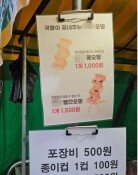Korean mask dance is certain to be listed on the UNESCO Intangible Heritage
Korean mask dance is certain to be listed on the UNESCO Intangible Heritage
Posted November. 02, 2022 08:02,
Updated November. 02, 2022 08:02

The Korean traditional mask dance, talchum, is almost certain to be listed as the UNESCO Masterpieces of the Oral and Intangible Heritage of Humanity. Talchum is going to be Korea’s 22nd intangible heritage to be listed.
On Tuesday, the Cultural Heritage Administration announced that a subpanel of the UNESCO Intergovernmental Committee for the Safeguarding of the Intangible Cultural Heritage recommended Korea’s traditional mask dance talchum for inscription on the list. The subpanel’s recommendation has rarely been reversed in the final stage. The evaluation body stated that the Korean government’s application for the inscription of talchum as an intangible heritage “provided a clear explanation about talchum’s societal function and cultural significance, and the government’s continued efforts to address adverse impact ensuing from excessive commercialization.”
The evaluation body screens the applications and classifies them as “inscribe,” “refer,” and “not to inscribe” and gives the recommendations to the UNESCO Intangible Heritage Committee. The final decision will be rendered in the 17th Intergovernmental Committee for the Safeguarding of the Intangible Cultural Heritage, which is set to take place in Morocco from Nov. 28 to Dec. 3. The Cultural Heritage Administration announced that the listing of talchum on the UNESCO Intangible Heritage of Humanity would be a chance to reinforce the sense of community and cultural identity of Koreans.
Talchum is a mixed art form encompassing dance, singing, and drama. It deals with social agendas and irregularities through actors’ speaking, dancing, singing, and gesture dynamically and humorously. While criticizing social injustices and absurdities, talchum presents them in a satirical and humorously insightful form. Talchum can be performed even where there is no proper stage, and the audience’s participation is integral to the completion of the performance.
There are currently 13 forms of talchum inscribed as the national intangible heritage and five inscribed as intangible heritage by the city and province. Yangju Byeolsandae Nori, Tongyeong Ogwangdae, Goseong Ogwangdae, Gangneung Dano Festival’s Gwanno Gamyeongeuk, Bukcheong Saja Noreum (Lion Mask Dance), and Bongsan Talchum are among the 13 national intangible heritages. Gangwon Sokcho Saja Nori and Gyeonggi Toegyewon Sandae Nori are among the five city and province-level intangible heritage.
Since 2001 when Jongmyo Jerye (Rite for worshipping the late kings and queens) and Jongmyo Jeryeak (royal ancestral ritual music) were listed for the first time in Korea as the intangible heritage of humanity, the Republic of Korea has listed 21 intangible heritages so far.
North Korea’s Pyongyang Raengmyon received the “inscribe” recommendation from the evaluation body. The evaluation body gave the “inscribe” recommendations to a total of 31 items, including the talchum of the Republic of Korea.
Seong-Taek Jeong neone@donga.com
Headline News
- Joint investigation headquarters asks Yoon to appear at the investigation office
- KDIC colonel: Cable ties and hoods to control NEC staff were prepared
- Results of real estate development diverged by accessibility to Gangnam
- New budget proposal reflecting Trump’s demand rejected
- Son Heung-min scores winning corner kick







